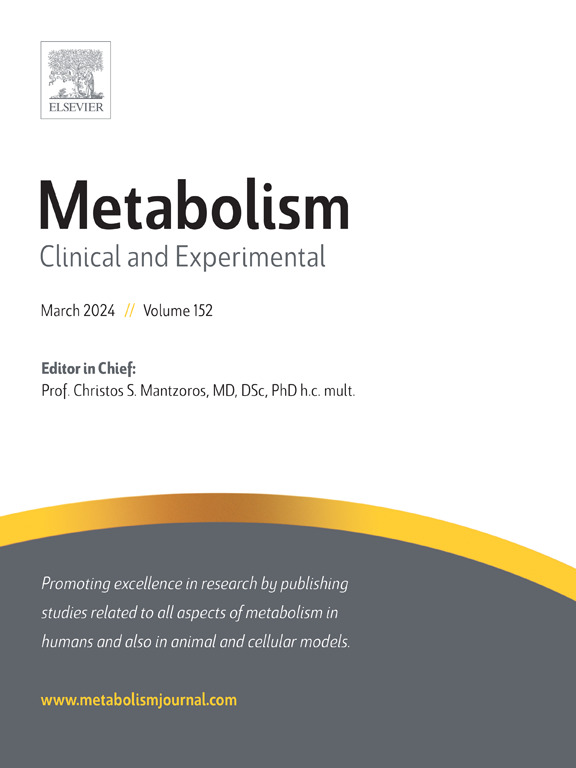由于PAPPA2缺乏导致IGF-1生物利用度的改变导致性别特异性代谢紊乱
IF 11.9
1区 医学
Q1 ENDOCRINOLOGY & METABOLISM
引用次数: 0
摘要
生长激素(GH)/胰岛素样生长因子(IGF-1)轴决定最佳生长并影响代谢和能量稳态。妊娠相关血浆蛋白a2 (PAPPA2)调节生物活性IGF-1的可用性,PAPPA2缺乏的患者生长和葡萄糖代谢受损。这条轴在代谢紊乱如肥胖和神经性厌食症中以一种性别特异性的方式发生改变,但涉及的机制尚未完全了解。在这里,我们评估了Pappa2缺乏如何影响能量稳态,重点是男性和女性的差异。方法测定雄性和雌性Pappa2ko/ko小鼠和对照Pappa2wt/wt幼崽的生长和能量稳态,以及它们对重组人(rh)PAPPA2、rhIGF-1和rhIBFBP5的反应。研究了高碳水化合物饮食(HCHD)对葡萄糖耐量、燃料分配、新生脂肪生成和能量稳态的影响。结果spappa2ko /ko小鼠的体重、骨长和脂质沉积均减少,能量消耗和摄入增加。雄性Pappa2ko/ko小鼠出现轻度葡萄糖耐受不良,骨矿物质特性改变,运动活动的能量消耗增加,这可能是由于肌肉线粒体活动效率低下所致;而雌性Pappa2ko/ko小鼠在正常饮食中有增强的脂肪酸氧化,但在HCHD中没有。所有的Pappa2ko/ko小鼠肝脏脂肪沉积较低,肝脏IGF-1活性较低,而脂肪组织脂肪酸代谢失调仅在雌性中发现。结论这些数据加强了GH/IGF-1轴在代谢控制中的重要性,并强调了Pappa2对其微调控制的相关性。此外,代谢失衡的性别差异强调了治疗代谢失衡的性别特异性策略的相关性。本文章由计算机程序翻译,如有差异,请以英文原文为准。

Alteration of IGF-1 bioavailability due to PAPPA2 deficiency leads to sex-specific metabolic disturbances
Background
The growth hormone (GH)/insulin-like growth factor (IGF-1) axis determines optimal growth and affects metabolism and energy homeostasis. Pregnancy-associated plasma protein-A2 (PAPPA2) regulates bioactive IGF-1 availability and patients with PAPPA2 deficiency have impaired growth and glucose metabolism. This axis is altered in metabolic disturbances such as obesity and anorexia nervosa in a sex-specific manner, but the mechanisms involved are not completely understood. Here we evaluated how Pappa2 deficiency affects energy homeostasis, focusing on male and female differences.
Methods
Growth and energy homeostasis were determined in male and female Pappa2ko/ko mice and control Pappa2wt/wt littermates, as well as their response to recombinant human (rh)PAPPA2, rhIGF-1 and rhIBFBP5. Effects of a high-carbohydrate diet (HCHD) on glucose tolerance, fuel partitioning, de novo lipogenesis and energy homeostasis were determined.
Results
Pappa2ko/ko mice had reduced body weight, bone length and lipid deposition associated with higher energy expenditure and intake. Male Pappa2ko/ko mice had mild glucose intolerance, altered bone mineral properties and higher energy costs for locomotor activity possibly due to inefficient muscle mitochondrial activity; whereas female Pappa2ko/ko mice had enhanced fatty acid oxidation on a normal diet, but not on a HCHD. All Pappa2ko/ko mice had lower hepatic fat deposition associated with lower IGF-1 activity in the liver, while fatty acid metabolism dysregulation in adipose tissue was found only in females.
Conclusion
These data reinforce the importance of the GH/IGF-1 axis in metabolic control and emphasize the relevance of its fine-tuned control by Pappa2. Moreover, the differences between sexes in metabolic imbalances underscore the relevance of sex-specific strategies for treatment of metabolic imbalances.
求助全文
通过发布文献求助,成功后即可免费获取论文全文。
去求助
来源期刊

Metabolism: clinical and experimental
医学-内分泌学与代谢
CiteScore
18.90
自引率
3.10%
发文量
310
审稿时长
16 days
期刊介绍:
Metabolism upholds research excellence by disseminating high-quality original research, reviews, editorials, and commentaries covering all facets of human metabolism.
Consideration for publication in Metabolism extends to studies in humans, animal, and cellular models, with a particular emphasis on work demonstrating strong translational potential.
The journal addresses a range of topics, including:
- Energy Expenditure and Obesity
- Metabolic Syndrome, Prediabetes, and Diabetes
- Nutrition, Exercise, and the Environment
- Genetics and Genomics, Proteomics, and Metabolomics
- Carbohydrate, Lipid, and Protein Metabolism
- Endocrinology and Hypertension
- Mineral and Bone Metabolism
- Cardiovascular Diseases and Malignancies
- Inflammation in metabolism and immunometabolism
 求助内容:
求助内容: 应助结果提醒方式:
应助结果提醒方式:


